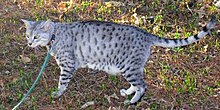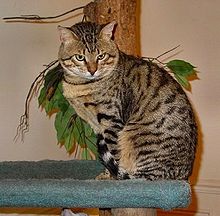

| Egyptian Mau | |
|---|---|

Bronze colored Mau
| |
| Origin | Egypt |
| Breed standards | |
| CFA | standard |
| FIFe | standard |
| TICA | standard |
| ACFA/CAA | standard |
| CCA-AFC | standard |
| Domestic cat (Felis catus) | |
Egyptian Maus are a small- to medium-sized short-haired cat breed. Along with the Bahraini Dilmun Cat, they are one of the few naturally spotted breeds of domesticated cat. The spots of the Mau occur on only the tips of the hairs of their coat.
The breed conformation is described by The Cornell Book of Catsas
a balance between the compactness of a Burmese and the slim elegance of a Siamese. Its medium-length body is muscular, with the hind legs longer than the front, giving the Mau the appearance of standing on tiptoes when upright.[1]
They frequently land on their back feet when taking a leap, making them appear rather haughty and kangaroo-like. The Egyptian Mau is the fastest of the domestic cats,[2] with its longer hind legs, and unique flap of skin extending from the flank to the back knee, providing for greater agility and length of stride. Maus have been clocked running more than 30 mph (48 km/h).[2]
Maus often possess very musical voices. They are known to chirp, chortle, and emit other distinctly unusual vocalizations when stimulated.[3] Another behavior, quite common in happy Maus, has been described as "wiggle-tail." The cat, whether female or male, wiggles and twitches its tail, and appears to be marking territory, also known as spraying, but during this behavior the Mau is not releasing urine. Even veteran Mau owners are known to check after a joyous Mau does this little dance.[4] Facial expressions may change according to mood, and eye color may change from green to turquoise. [citation needed]

The modern Egyptian Mau is said to have originated in 1952, in Italy, when exiled Russian Princess Natalie Trubetskaya met the cat of the Egyptian Ambassador to Italy.[5] After convincing him to obtain several cats from Egypt for her, she began to breed them. Trubetskaya described her Maus as having a "troubled" look, with their round eyes and open expression. The breed name is derived from the Middle Egyptian word mw (literally, cat).
Despite claims that the breed originated in Egypt, DNA analysis shows mainly European and North American origins. The feline genome data published in the Pentascope document shows the Egyptian Mau to be very closely related to the Maine Coon, Korat, and American Turkish Angoras (not native Turkish Angoras).[6] The phylogenetic tree published in PlosOne demonstrates that the Egyptian Mau belongs to the group of Western-derived breeds.[7] The East Mediterranean/Anatolian group is omitted because breeds that supposedly originate in that geographic area do not do so.


The Mau achieved championship status in some organizations in 1968. There were attempts by British breeders to create Maus from cross-breeds of Abyssinians, Siamese and tabbies, however, these did not resemble the true Maus. This mix became the basis for the Ocicat.
Egyptian Maus will have either a 'scarab beetle' or 'M' marking on their foreheads,[8] those with the latter tend to be from the United States.[9]
Egyptian Maus typically are slender and muscular and they are thought to be one of the progenitor breeds of the modern domestic cat.[1] They have anatomical, metabolic, and behavioral differences from other cat breeds which could be considered evidence of antiquity or at least uniqueness from other cat breeds. Some anatomical differences are their legs, which are slightly shorter in the front than in the back. They also have a skin fold under the belly, resembling that of the cheetah, which assists in running by allowing the legs to stretch back farther. Also one of the most important recognizable "traits" of this particular animal is a long, dark, dorsal stripe that runs from its head to its tail along its spine.
The Mau is known for having what is considered a loyal, friendly personality.
Maus are more temperature sensitive than most breeds - they are fond of very warm temperatures.[1] They are more sensitive to medicines and anesthesia.[citation needed] Maus allegedly have an unusually long gestational period, about 73 days.[1] The maximum normal period for cats is 65–67 days, although Siamese may take a day or two longer.
Egyptian Maus are a relatively rare breed to encounter. As of 2007, fewer than 200 kittens are registered with the Governing Council of the Cat Fancy each year.[10] As of 2006, a total of 6,741 Maus were registered with the Cat Fanciers' Association.
Maus come in five colors. From most to least common these colors are: silver, bronze, smoke, black and blue/pewter.[11]
Black and pewter Maus cannot be shown, but may be used in breeding. All Maus must have green eyes, but an amber cast is acceptable in kittens and young adults up to eighteen months old.
EMRO is an adoption agency both locally and internationally for tame Maus. Supported solely by private and corporate donors, EMRO aims to increase education, in Egypt and around the world, about cats.[12] EMRO's cats are not pedigreed Egyptian Maus; they are Egyptian and Arabian street cats of unknown pedigree. The only cats that legitimately may be called Egyptian Maus are cats with registration papers from a reputable registry that certify them as such. Although EMRO's cats come from the Egyptian Mau's current region of import, CFA, the world's largest registry of pedigreed cats, will not consider these cats and their offspring Egyptian Maus unless they have met a number of exacting requirements to rule out disqualifying physical traits and detailed record-keeping to verify parentage. The first generation imported cats themselves are considered to be native Maus and their second and third generation offspring are considered domestic Maus. Finally, the fourth generation cats are eligible for placement on the active registry provided they have been evaluated fully and approved by a designated representative of the Egyptian Mau Breed Council.[13]